In the depths of Mars with a thermometer
The idea of plunging scientific instruments deeper into Mars had arisen before, but these devices still had no luck. "Mars-96" with penetrators, which could plunge to 5-6 meters, could not fly from the Earth's orbit. Mars Polar Lander with similar mini-probes, capable of diving for half a meter, entered the atmosphere and disappeared without a trace. On May 5, a new InSight mission will be sent to Mars, one of whose goals is to immerse the tape with temperature sensors to a depth of 5 meters.

InSight on the surface of Mars, NASA pattern
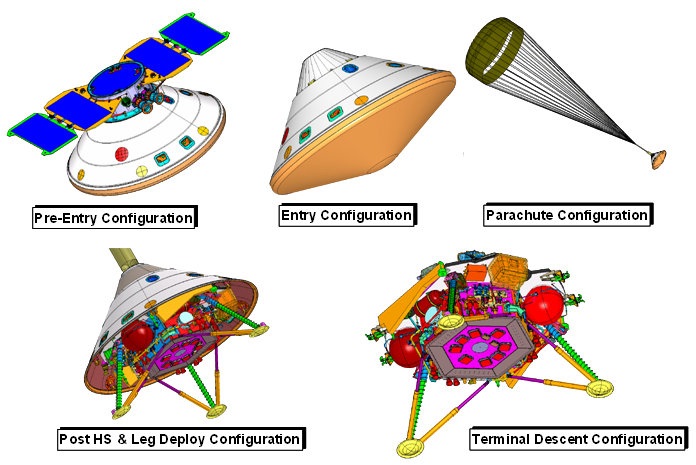
View of InSight at different stages of the flight, hereinafter photos and drawings of NASA
Structurally, InSight is built on the basis of a successful Phoenix probe, which safely landed on Mars in 2008. The device consists of a migratory step, aerial shell with thermal protection, a parachute and the probe itself. The total weight is 727 kg, of which the probe itself weighs 360 kg. To save weight and money, not only was the reuse of structures already working on Mars, but also ingenious technical solutions — for example, there are no engines of their own at the migratory stage; therefore, holes for the engines installed on the probe frame are cut in the aero shell. There are no pressurized gas tanks in the propulsion system. Usually they provide constant fuel pressure at the engine inlet and consistency in their performance. At InSight, with every second of engine performance, the pressure will drop, and the control system will recalculate the engine's deteriorating thrust.

Migratory stage
Migratory stage with a mass of 80 kg carries solar panels, star and solar sensors, as well as antennas. The solar panels cannot rotate, so in the first months of the flight of the device, while it is located near the Sun, InSight will take a position at an angle to it, and then reorient so that the panels become perpendicular to the sunlight. Interestingly, unlike Curiosity, the migratory stage will not be stabilized by a twist; instead, the control system will maintain a constant triaxial orientation. The flight level will be reset shortly before entering the atmosphere.
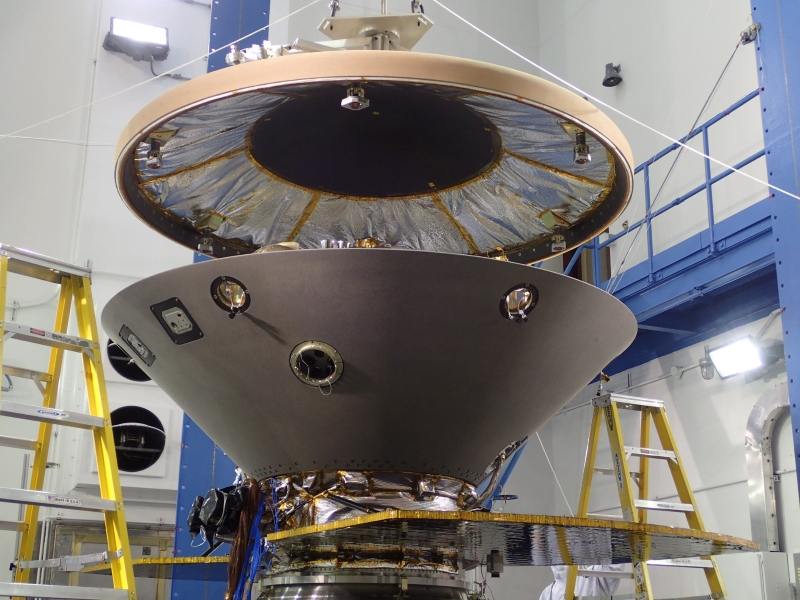
Aeroball
The aerial shell consists of sixty-two-kilogram heat shield and the rear part weighing 110 kg. Constructively, it is a copy of the air shell of the Phoenix probe, and engineering solutions like the half-angle of a 70 ° cone go back to the “Vikings” of the 70s of the 20th century. As the thermal protection is used ablative (evaporating) material, which was used on all US Martian vehicles except Curiosity. The thickness of the heat-shielding layer is slightly increased compared to Phoenix, because it was expected that InSight would sink into the Martian dust storm, and the heat protection would be more sandblasted. However, the transfer of the start from 2016 to 2018 due to the unavailability of one of the scientific instruments led to the fact that the rate of entry into the atmosphere (and the load on the thermal protection) will be lower than the original.
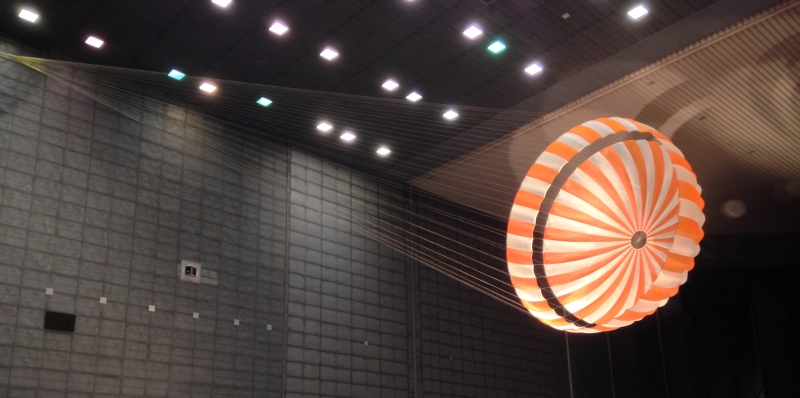
Parachute
The parachute is generally similar to that of the Phoenix and differs only in reinforced slings in order to withstand the load increased by 15%. It will have to open at an altitude of 10.5 km and a speed of 1.7M.
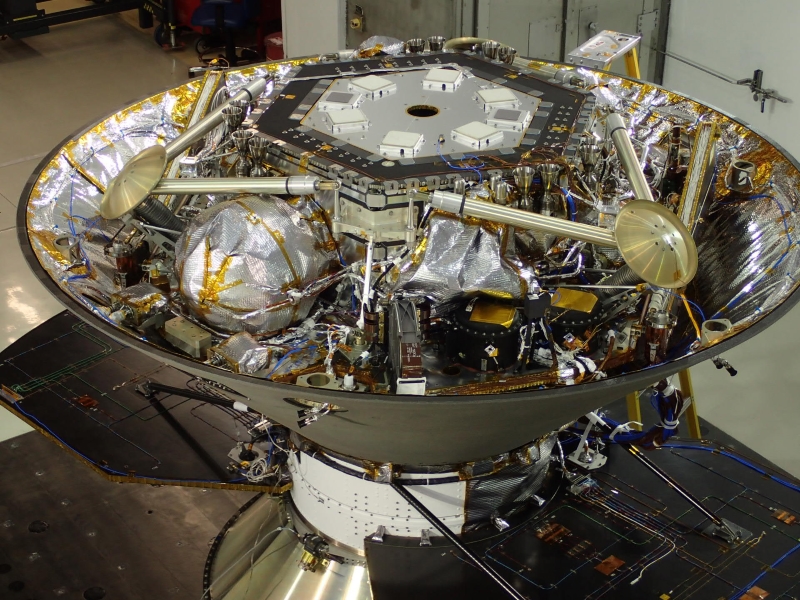
InSight folded under the shell
Structurally, InSight is largely based on Phoenix, and this is clearly visible - it has a similar hexagonal frame, the same round solar panels and three folding landing supports. The biggest difference is the on-board computer - the Phoenix was made on the basis of the canceled Mars Surveyor, which was supposed to start in 2001, so the computer remained on it in the technologies of the 90s. On InSight, according to unconfirmed information, a modern RAD-750 is installed, successfully working on Juno, MAVEN, GRAIL. But lithium-ion batteries on the InSight are exactly the same as on the Phoenix, despite the progress in this area over the past ten years.
The process of landing InSight is similar to Phoenix (in the video above it was he). At an altitude of 5.5 km, the landing radar should turn on, the probe will be separated from the upper part of the aerial shell with a parachute by 1.1 km and will start descending on 12 engines operating in pulsed mode. Close to the surface, he will need to brake and sit down at a speed not exceeding 2.4 m / s. The landing pillars must withstand a 16 °
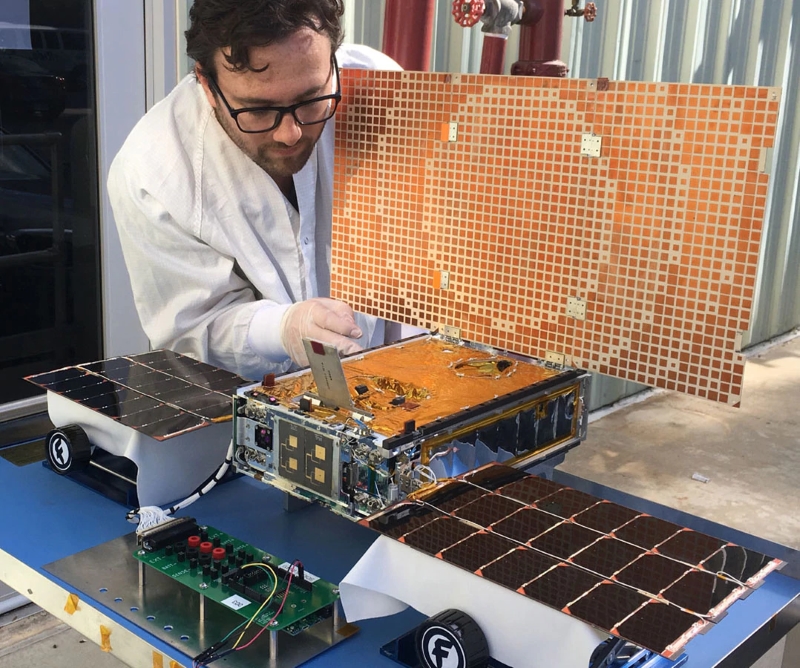
tilt at the same time and stones up to 40 cm. One of the MarCO vehicles.
Interestingly, InSight will not fly to Mars alone - the first WCO-E and EVA interplanetary Kubsat in history will go with him. . Their task will be a technological demonstration of the work of the Kubsat in deep space - both devices will have to retransmit InSight telemetry to Earth during landing.
Three scientific instruments are installed onboard the InSight.

SEIS - Seismic Experiment for Interior Structure is the most sensitive seismometer ever installed on space probes. Seismometers were sent to Mars before, but, for example, on the Vikings, one refused, and the second turned out to be practically useless because it stood on the device itself and recorded wind gusts and equipment vibration instead of useful data. Therefore, in the case of InSight, the seismometer will be unloaded to the surface and covered with a special cap to protect it from interference due to wind and temperature fluctuations.
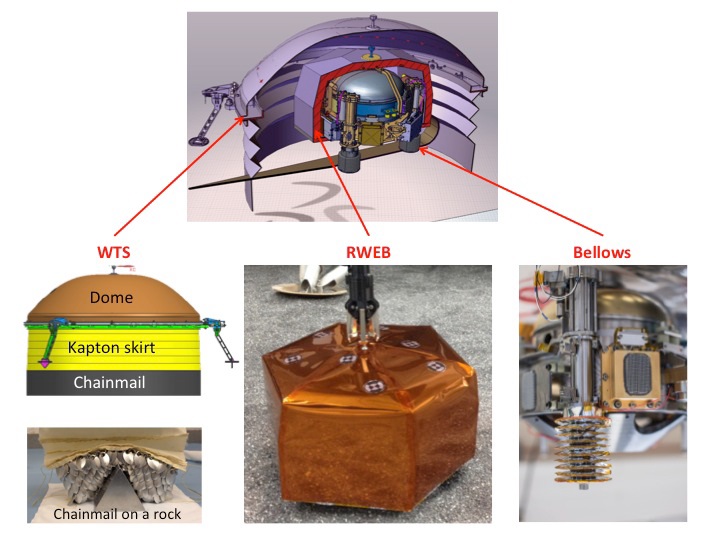
SEIS cap section
The main sensing elements of SEIS are two types of sensors located inside the vacuum sphere - three broadband seismometers with reverse pendulums are complemented by three sensors that record short-period events. The main sensors are complemented by a variety of other sensors and a weather station similar to Curiosity, to account for and eliminate meteorological interference. The device was developed together by scientists and engineers from the USA, France, Great Britain and Switzerland and became the main headache of the mission - due to a breach of its tightness, the start had to be delayed for two years. A separate challenge was to protect this very sensitive device at the start from the vibrations of the launch vehicle.
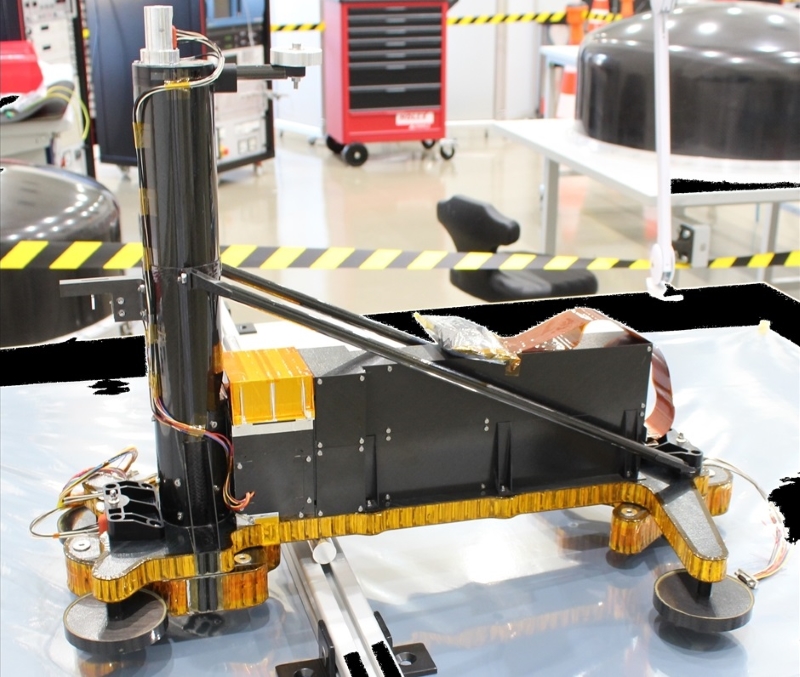
HP 3 - Heat Flow and Physical Properties ProbeIt is essentially a five-meter tape with a thermometer for every 35 cm. In order for it to be able to dive into Mars, a special “mole” has been created that works according to the principle of pile driving - a spring load will hit the bottom of the structure, plunging it deeper . The cycle will take 200 milliseconds and will have to immerse the mole by 0.1-1 mm. Every 50 cm “mole” will stop for three days to measure the temperature conductivity at this depth.
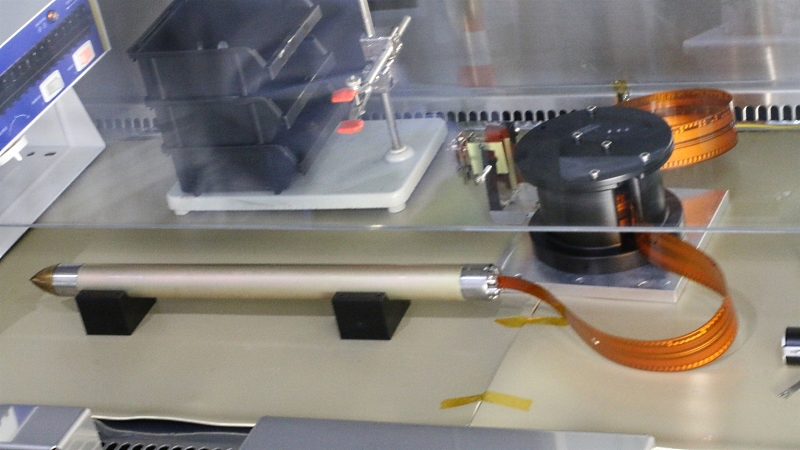
"Mole" and a tape with sensors close-up
In addition, a radiometer is installed on the probe frame that will measure the surface temperature. The obtained data will give geologists extremely valuable information about the history of Mars and about the life cycle of rocky planets as a whole. Also, the temperature profile can help find out exactly how Mars lost its magnetic field.

Top view of an InSight frame, antennas marked with an arrow
RISE - Rotation and Interior Structure Experiment- This experiment is designed to very accurately determine the parameters of rotation of Mars around its axis. Technically, this is realized through a transponder and two antennas transmitting a signal to Earth. Antennas are directed to the sides, because when the Earth is low above the horizon, measurements are most accurate. Knowing how Mars rotates, what precession and nutation it is experiencing, will help to learn more about the core of the planet, whether it is in a liquid or solid state.

In order to transfer the RISE seismometer and the HP 3 thermometer from the frame to the surface of Mars , a special manipulator arm was required, which is structurally similar to the manipulator of the canceled Mars Surveyor probe. Also on InSight there are two cameras - one on the manipulator, the other on the frame, where she can see the devices installed on the surface.
According to the plan, the start should take place on May 5 at 14:05 Moscow time. The Atlas V rocket of the lightest version 401 is used to remove the probe. First, the second stage and the probe must go to a low orbit, and after the turn, the second stage engine will turn on a second time, and InSight will have to be on its way to Mars.
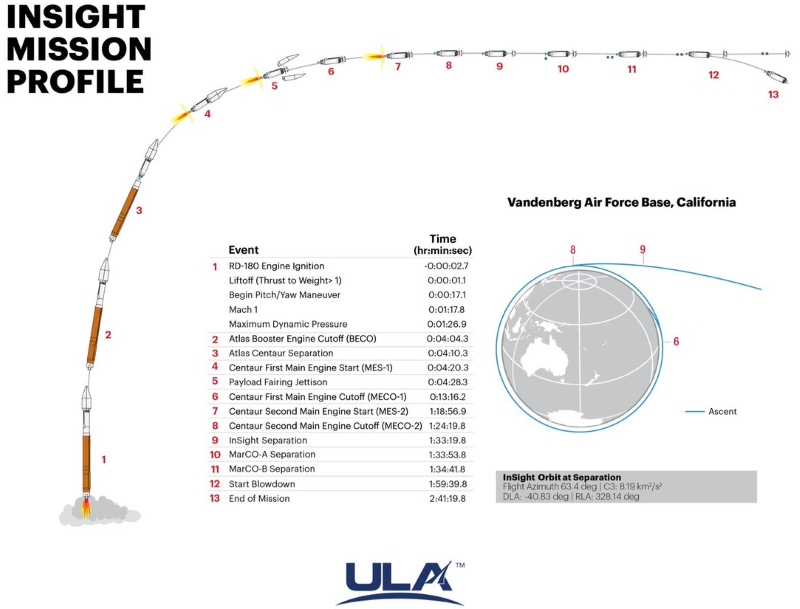
Inference map, ULA image

InSight on the surface of Mars, NASA pattern
Apparatus

View of InSight at different stages of the flight, hereinafter photos and drawings of NASA
Structurally, InSight is built on the basis of a successful Phoenix probe, which safely landed on Mars in 2008. The device consists of a migratory step, aerial shell with thermal protection, a parachute and the probe itself. The total weight is 727 kg, of which the probe itself weighs 360 kg. To save weight and money, not only was the reuse of structures already working on Mars, but also ingenious technical solutions — for example, there are no engines of their own at the migratory stage; therefore, holes for the engines installed on the probe frame are cut in the aero shell. There are no pressurized gas tanks in the propulsion system. Usually they provide constant fuel pressure at the engine inlet and consistency in their performance. At InSight, with every second of engine performance, the pressure will drop, and the control system will recalculate the engine's deteriorating thrust.

Migratory stage
Migratory stage with a mass of 80 kg carries solar panels, star and solar sensors, as well as antennas. The solar panels cannot rotate, so in the first months of the flight of the device, while it is located near the Sun, InSight will take a position at an angle to it, and then reorient so that the panels become perpendicular to the sunlight. Interestingly, unlike Curiosity, the migratory stage will not be stabilized by a twist; instead, the control system will maintain a constant triaxial orientation. The flight level will be reset shortly before entering the atmosphere.

Aeroball
The aerial shell consists of sixty-two-kilogram heat shield and the rear part weighing 110 kg. Constructively, it is a copy of the air shell of the Phoenix probe, and engineering solutions like the half-angle of a 70 ° cone go back to the “Vikings” of the 70s of the 20th century. As the thermal protection is used ablative (evaporating) material, which was used on all US Martian vehicles except Curiosity. The thickness of the heat-shielding layer is slightly increased compared to Phoenix, because it was expected that InSight would sink into the Martian dust storm, and the heat protection would be more sandblasted. However, the transfer of the start from 2016 to 2018 due to the unavailability of one of the scientific instruments led to the fact that the rate of entry into the atmosphere (and the load on the thermal protection) will be lower than the original.

Parachute
The parachute is generally similar to that of the Phoenix and differs only in reinforced slings in order to withstand the load increased by 15%. It will have to open at an altitude of 10.5 km and a speed of 1.7M.

InSight folded under the shell
Structurally, InSight is largely based on Phoenix, and this is clearly visible - it has a similar hexagonal frame, the same round solar panels and three folding landing supports. The biggest difference is the on-board computer - the Phoenix was made on the basis of the canceled Mars Surveyor, which was supposed to start in 2001, so the computer remained on it in the technologies of the 90s. On InSight, according to unconfirmed information, a modern RAD-750 is installed, successfully working on Juno, MAVEN, GRAIL. But lithium-ion batteries on the InSight are exactly the same as on the Phoenix, despite the progress in this area over the past ten years.
The process of landing InSight is similar to Phoenix (in the video above it was he). At an altitude of 5.5 km, the landing radar should turn on, the probe will be separated from the upper part of the aerial shell with a parachute by 1.1 km and will start descending on 12 engines operating in pulsed mode. Close to the surface, he will need to brake and sit down at a speed not exceeding 2.4 m / s. The landing pillars must withstand a 16 °

tilt at the same time and stones up to 40 cm. One of the MarCO vehicles.
Interestingly, InSight will not fly to Mars alone - the first WCO-E and EVA interplanetary Kubsat in history will go with him. . Their task will be a technological demonstration of the work of the Kubsat in deep space - both devices will have to retransmit InSight telemetry to Earth during landing.
Scientific devices
Three scientific instruments are installed onboard the InSight.

SEIS - Seismic Experiment for Interior Structure is the most sensitive seismometer ever installed on space probes. Seismometers were sent to Mars before, but, for example, on the Vikings, one refused, and the second turned out to be practically useless because it stood on the device itself and recorded wind gusts and equipment vibration instead of useful data. Therefore, in the case of InSight, the seismometer will be unloaded to the surface and covered with a special cap to protect it from interference due to wind and temperature fluctuations.

SEIS cap section
The main sensing elements of SEIS are two types of sensors located inside the vacuum sphere - three broadband seismometers with reverse pendulums are complemented by three sensors that record short-period events. The main sensors are complemented by a variety of other sensors and a weather station similar to Curiosity, to account for and eliminate meteorological interference. The device was developed together by scientists and engineers from the USA, France, Great Britain and Switzerland and became the main headache of the mission - due to a breach of its tightness, the start had to be delayed for two years. A separate challenge was to protect this very sensitive device at the start from the vibrations of the launch vehicle.

HP 3 - Heat Flow and Physical Properties ProbeIt is essentially a five-meter tape with a thermometer for every 35 cm. In order for it to be able to dive into Mars, a special “mole” has been created that works according to the principle of pile driving - a spring load will hit the bottom of the structure, plunging it deeper . The cycle will take 200 milliseconds and will have to immerse the mole by 0.1-1 mm. Every 50 cm “mole” will stop for three days to measure the temperature conductivity at this depth.

"Mole" and a tape with sensors close-up
In addition, a radiometer is installed on the probe frame that will measure the surface temperature. The obtained data will give geologists extremely valuable information about the history of Mars and about the life cycle of rocky planets as a whole. Also, the temperature profile can help find out exactly how Mars lost its magnetic field.

Top view of an InSight frame, antennas marked with an arrow
RISE - Rotation and Interior Structure Experiment- This experiment is designed to very accurately determine the parameters of rotation of Mars around its axis. Technically, this is realized through a transponder and two antennas transmitting a signal to Earth. Antennas are directed to the sides, because when the Earth is low above the horizon, measurements are most accurate. Knowing how Mars rotates, what precession and nutation it is experiencing, will help to learn more about the core of the planet, whether it is in a liquid or solid state.

In order to transfer the RISE seismometer and the HP 3 thermometer from the frame to the surface of Mars , a special manipulator arm was required, which is structurally similar to the manipulator of the canceled Mars Surveyor probe. Also on InSight there are two cameras - one on the manipulator, the other on the frame, where she can see the devices installed on the surface.
Start
According to the plan, the start should take place on May 5 at 14:05 Moscow time. The Atlas V rocket of the lightest version 401 is used to remove the probe. First, the second stage and the probe must go to a low orbit, and after the turn, the second stage engine will turn on a second time, and InSight will have to be on its way to Mars.

Inference map, ULA image
